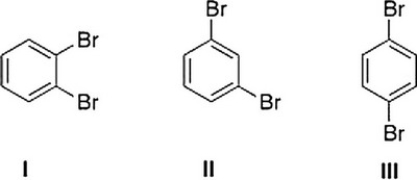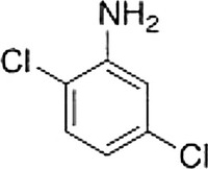Deck 18: Benzene and Aromatic Compounds
Question
Question
Question
Question
Question
Question
Question
Question
Question
Question

Unlock Deck
Sign up to unlock the cards in this deck!
Unlock Deck
Unlock Deck
1/10
Play
Full screen (f)
Deck 18: Benzene and Aromatic Compounds
1
Which of the following compounds is not aromatic? 
A) I
B) IV
C) II
D) III

A) I
B) IV
C) II
D) III
I
2
Which of the following compounds is aromatic? 
A) I
B) IV
C) II
D) III

A) I
B) IV
C) II
D) III
IV
3
Why is the following compound not aromatic? 
A) It is not cyclic.
B) The pi electron system is not continuous.
C) It has 4n+2 pi electrons.
D) It has 4n pi electrons.

A) It is not cyclic.
B) The pi electron system is not continuous.
C) It has 4n+2 pi electrons.
D) It has 4n pi electrons.
The pi electron system is not continuous.
4
What is the name of the following compound? 
A) 5-Methyltoluene
B) 2,6-Dimethylbenzene
C) Anisole
D) 1,3-Dimethylbenzene

A) 5-Methyltoluene
B) 2,6-Dimethylbenzene
C) Anisole
D) 1,3-Dimethylbenzene

Unlock Deck
Unlock for access to all 10 flashcards in this deck.
Unlock Deck
k this deck
5
Which of the following compounds is aromatic? 
A) II
B) IV
C) III
D) I

A) II
B) IV
C) III
D) I

Unlock Deck
Unlock for access to all 10 flashcards in this deck.
Unlock Deck
k this deck
6
Which of the following statements about the molecular orbital (MO) theory is true? 
A) Ap* antibonding molecular orbital is higher in energy than the two atomicp orbitals from which it is formed.
B) When twop orbitals of similar phase overlap side-by-side, a p* antibonding molecular orbital is formed.
C) Ap bonding molecular orbital is higher in energy than the two atomicp orbitals from which it is formed.
D) When twop orbitals of opposite phase overlap side-by-side, a p bonding molecular orbital is formed.

A) Ap* antibonding molecular orbital is higher in energy than the two atomicp orbitals from which it is formed.
B) When twop orbitals of similar phase overlap side-by-side, a p* antibonding molecular orbital is formed.
C) Ap bonding molecular orbital is higher in energy than the two atomicp orbitals from which it is formed.
D) When twop orbitals of opposite phase overlap side-by-side, a p bonding molecular orbital is formed.

Unlock Deck
Unlock for access to all 10 flashcards in this deck.
Unlock Deck
k this deck
7
What is the correct assignment of the number of signals in the 13C NMR spectra of the following disubstituted benzene derivatives? 
A) I = 6 signals; II = 6 signals; III = 6 signals
B) I = 3 signals; II = 4 signals; III = 2 signals
C) I = 3 signals; II = 4 signals; III = 3 signals
D) I = 3 signals; II = 3 signals; III = 2 signals

A) I = 6 signals; II = 6 signals; III = 6 signals
B) I = 3 signals; II = 4 signals; III = 2 signals
C) I = 3 signals; II = 4 signals; III = 3 signals
D) I = 3 signals; II = 3 signals; III = 2 signals

Unlock Deck
Unlock for access to all 10 flashcards in this deck.
Unlock Deck
k this deck
8
Which of the following compounds is not aromatic? 
A) III
B) II
C) IV
D) I

A) III
B) II
C) IV
D) I

Unlock Deck
Unlock for access to all 10 flashcards in this deck.
Unlock Deck
k this deck
9
What is the correct assignment of the names of the following fused aromatic compounds? ![<strong>What is the correct assignment of the names of the following fused aromatic compounds? </strong> A) I = naphthalene; II = phenanthrene; III = anthracene B) I = naphthalene; II = anthracene; III = phenanthrene C) I = anthracene; II = naphthalene; III = phenanthrene D) I = naphthalene; II = phenanthrene; III = benzo[a]pyrene](https://d2lvgg3v3hfg70.cloudfront.net/TBMG1035/11ee4665_5cfe_614c_862d_8b402207188d_TBMG1035_00.jpg)
A) I = naphthalene; II = phenanthrene; III = anthracene
B) I = naphthalene; II = anthracene; III = phenanthrene
C) I = anthracene; II = naphthalene; III = phenanthrene
D) I = naphthalene; II = phenanthrene; III = benzo[a]pyrene
![<strong>What is the correct assignment of the names of the following fused aromatic compounds? </strong> A) I = naphthalene; II = phenanthrene; III = anthracene B) I = naphthalene; II = anthracene; III = phenanthrene C) I = anthracene; II = naphthalene; III = phenanthrene D) I = naphthalene; II = phenanthrene; III = benzo[a]pyrene](https://d2lvgg3v3hfg70.cloudfront.net/TBMG1035/11ee4665_5cfe_614c_862d_8b402207188d_TBMG1035_00.jpg)
A) I = naphthalene; II = phenanthrene; III = anthracene
B) I = naphthalene; II = anthracene; III = phenanthrene
C) I = anthracene; II = naphthalene; III = phenanthrene
D) I = naphthalene; II = phenanthrene; III = benzo[a]pyrene

Unlock Deck
Unlock for access to all 10 flashcards in this deck.
Unlock Deck
k this deck
10
What is the IUPAC name of the following compound? 
A) 2,5-Dichloroaminobenzene
B) 2,5-Dichloroaniline
C) 2,5-Dichloroanisole
D) 3,6-Dichloroaniline

A) 2,5-Dichloroaminobenzene
B) 2,5-Dichloroaniline
C) 2,5-Dichloroanisole
D) 3,6-Dichloroaniline

Unlock Deck
Unlock for access to all 10 flashcards in this deck.
Unlock Deck
k this deck



